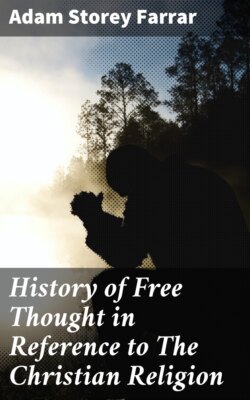Читать книгу History of Free Thought in Reference to The Christian Religion - Adam Storey Farrar - Страница 9
На сайте Литреса книга снята с продажи.
Lecture VI.
ОглавлениеTable of Contents
Free Thought in the Theology of Germany, from 1750–1835.
This is the third phase of free thought in that which was called the fourth crisis of faith.—Importance of the movement, which is called “rationalism,” as the theological phase of the literary movement of Germany (p. 210).—Deviation from the plan previously adopted, in that a sketch is here given of German theological inquiry generally, and not merely of unbelief (p. 211).
Brief preliminary sketch of German theology since the Reformation. Two great tendencies shown in it during the seventeenth century (p. 211).
(1) The dogmatic and scholastic, science without earnestness (p. 212). (2) The pietistic, earnestness without science (p. 213).
In the first half of the eighteenth century, three new influences are introduced (pp. 213, 214), which are the means of creating rationalism in the latter half: viz.
(α) The philosophy of Wolff, explained to be a formal expression of Leibnitz's principles; and the evil effect of it, accidental and indirect (pp. 214–216). (β) The works of the English deists (p. 216). (γ) The influence of the colony of French infidels at the court of Frederick II. of Prussia (p. 217).
[pg xxxviii]
The subsequent history is studied in three periods (p. 218); viz.
Period I. (1750–1810).—Destructive in character, inaugurated by Semler (pp. 218–234). Period II. (1810–1835).—Reconstructive in character, inaugurated by Schleiermacher (pp. 239–261). Period III. (1835 to present time)—Exhibiting definite and final tendencies, inaugurated by Strauss (Lect. VII).
Period I. (1750–1810), is studied under two Sub-periods:
Sub-period I. (1750–1790, pp. 219–228), which includes three movements; (1) Within the church (p. 219 seq.); dogmatic; literary in Michaelis and Ernesti; and freethinking in Semler (pp. 221–224), the author of the historic method of interpretation. (2) External to the church (pp. 224–226); literary deism in Lessing, and in the Wolfenbüttel fragments of Reimarus (p. 225). (3) External to the church; practical deism, in the educational institutions of Basedow (p. 227).
Sub-period II. (1790–1810, pp. 227–234); the difference caused by the introduction of two new influences; viz,
(α) The literary, of the court of Weimar and of the great men gathered there (p. 228). (β) The philosophy of Kant, (the effect of which is explained, pp. 229, 230); the home of both of which was at Jena.
As the result of these new influences, three movements are visible in the Church (p. 230); viz,
(1) The critical “rationalism” of Eichhorn and Paulus, the intellectual successors of Semler (pp. 231, 232). (2) The dogmatic, more or less varying from orthodoxy, seen towards the end of this period in Bretschneider, Röhr, and Wegscheider (pp. 233, 234). (3) The supernaturalism of Reinhardt and Storr (p. 231).
Period II. (1810–1835.)—Introduction of four new influences (p. 235), which completely altered the theological tone; viz. (α) New systems of speculative philosophy; of Jacobi, who followed out the material element of Kant's philosophy (p. 235); and of Fichte, Schelling, and Hegel, who followed out the formal (p. 238). (β) The “romantic” school of poetry (p. 239). (γ) The moral tone, generated by the liberation wars of 1813. (p. 240.) (δ) The excitement caused by the theses of Harms at the tercentenary of the Reformation in 1817. (pp. 240, 241.)
[pg xxxix]
The result of these is seen (p. 241) in
(1) An improved doctrinal school under Schleiermacher (pp. 241−250), (description of his Glaubenslehre, p. 245 seq.); and under his successors, Neander, &c. (pp. 250–252.) (2) An improved critical tone (p. 252 seq.) as seen in De Wette and Ewald, which is illustrated by an explanation of the Pentateuch controversy (pp. 254–258).
Concluding notice of two other movements to be treated in the next lecture (p. 259); viz.
(1) an attempt, different from that of Schleiermacher, in the school of Hegel, to find a new philosophical basis for Christianity; and (2) the return to the biblical orthodoxy of the Lutheran church.
Remarks on the benevolence of Providence in overruling free inquiry to the discovery of truth. (pp. 259–261).
